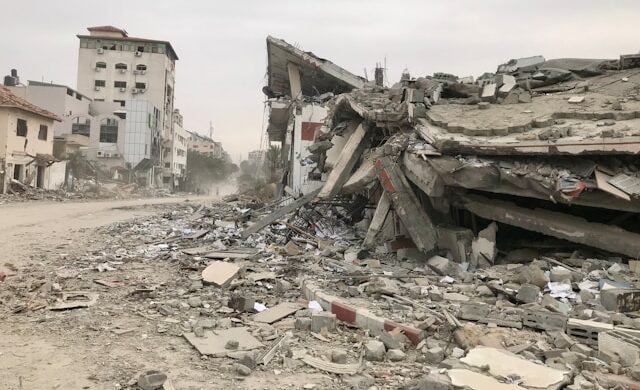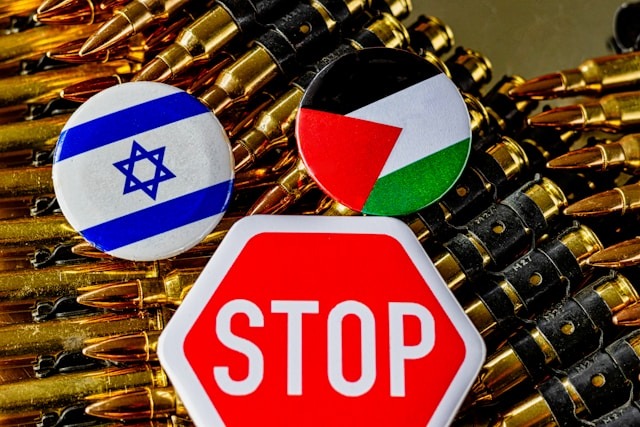Compromise or conflict?
At some point in a dispute or confrontation, a choice must be made: to compromise or continue to engage in conflict.
This choice usually comes down to an endgame, where a particular party wants to end up after the dispute or confrontation.
Conflict usually continues when a particular party’s endgame is to achieve its objective in totality.
This usually comes from extreme parties, which are so rigid in their goals that they’ll do anything and sacrifice anything to achieve them.
Compromise is achieved when the parties value the good over the perfect for an endgame. This means they may not achieve all their goals in absolute totality but will achieve an endgame that leads to something substantial, and the sacrifices they need to give up in achieving this endgame are much less impactful than the sacrifices of conflict.
This choice between compromise and conflict has defined the Israel-Palestine issue going back to the early 1990s and has directly led to the Israel-Hamas War.
This choice also directly affects how the war and dispute will find its endgame.
Here, we’ll examine why the rejection of compromise for conflict has led to the current situation, how embracing compromise could still solve the problem and the role that we, as the United States, could have in this issue’s endgame.

Conflict Over Compromise
The conflict between Israel and Palestine is a dispute between two groups of people who claim the same land.
It goes back to the early 1900s and the 1947 United Nations adopted proposal dividing the region into the two states of Israel and Palestine after World War 2. And while it has a complex history involving other states in the region and includes many wars and conflicts, the bulk of the current situation starts in the 1990s.
In 1993, the United States and President Bill Clinton brought Israeli Prime Minister Yitzhak Rabin and Chairman of the Palestine Liberation Organization Yasser Arafat to the White House to sign the first agreement of what would be known as the Oslo Accords.
The Oslo Accords were two agreements, the Oslo I Accord signed at the White House in 1993, and the Oslo II Accord signed in Taba, Egypt, in 1995, that started a process to give the Palestinians their own state and establish peace.
The signing of the Oslo Accords established the recognition of Israel and its sovereignty by the Palestine Liberation Organization and the recognition of the Palestine Liberation Organization by Israel as the official representative of the Palestinians.
It also established the Palestinian Authority, a governing body allowing the Palestinians the ability to govern themselves in specific areas of the West Bank and the Gaza Strip.
These were major breakthroughs, as two mortal enemies, locked in conflict for years, were finally signing agreements and beginning a process that could end in the establishment of two states and a peace treaty.
But there were problems. Extreme groups on both sides did not favor the Oslo Accords and its subsequent peace process.
In Israel, right-wing conservatives led by politicians like Benjamin Netanyahu and his Likud political party strongly opposed the accords and held large protests in dissent.
This opposition eventually evolved into violent extremism when a far-right Israeli extremist assassinated Prime Minister Yitzhak Rabin for signing the Oslo Accords.
With the Palestinians, a newly formed extremist militant group named Hamas was the main opposition to the Oslo process.
Hamas conducted suicide bombings in Israel as opposition, trying to disrupt the entire process. Their overarching goal was/is the destruction of Israel, and they did not, and do not, want any type of peace process.
As a result of the emergence and violence committed by Hamas, Benjamin Netanyahu and the Likud party gained in popularity and ran a campaign for Prime Minister of Israel.
Netanyahu’s campaign was based on security and protection against Hamas, and he used the Oslo Accords as a scapegoat for everything going on, eventually winning the election and becoming Prime Minister in 1996.
As Prime Minister, however, under pressure from the United States and President Bill Clinton, Netanyahu reluctantly continued Israel’s participation in the peace process but did nothing to encourage it.
And although Netanyahu lost his reelection bid in 1999, the damage to the peace process by him and Hamas may have already been done heading into the 2000 Camp David Summit.
As part of the summit, President Clinton brought Israel, represented by Prime Minister Ehud Barak, and the Palestinians, represented by Yasser Arafat, together again, this time at Camp David, as a last-ditch effort for the peace process.
Part of the Oslo Accords peace process was that all outstanding issues between Israel and Palestine should be agreed upon within five years, but this did not happen under the process and was not to the liking of either side.
This round of peace talks would have finalized the process of a peace agreement and created a Palestinian state in the West Bank and Gaza.
However, the two sides could not reach an agreement due to differences on certain specific issues, including what would become of Jerusalem.
The blame for the summit’s failure is controversial, but it is attributed to Yasser Arafat; President Bill Clinton has specifically blamed him in the past.
It is said that Arafat wouldn’t accept anything that didn’t meet all of his requirements and wouldn’t engage in counter-negotiations with Israel. However, others say that Arafat did make some concessions, but they weren’t enough.
Regardless, the result was that conflict won over compromise, and the entire Oslo process fell apart.
The extremes on both sides derailed the process, and the negotiators of the Camp David Summit would not put an endgame of peace over their goals.
What would the situation look like today if they did?

Compromise over Conflict?
Currently, the situation with Israel and Palestine has evolved into extreme conflict, miles away from the potential compromises of the 1990s.
In Israel, Benjamin Netanyahu is once again Prime Minister and a right-wing government has been established.
For the Palestinians, the extremist group Hamas is now the ruling regime in the Gaza Strip. However, the Fatah party, the largest group of the Palestine Liberation Organization, still controls the West Bank areas.
This has created a full-circle dynamic, where the current government holding power in Israel and the ruling regime in Gaza are the same two groups that directly opposed the Oslo peace process.
It should be no surprise that this dynamic has resulted in a direct war between the two.
So how can this issue get back to compromise from this extreme type of conflict?
It starts with the goals of the different groups involved and the removal of the extremes from control of the situation.
Hamas, a United States-designated terrorist organization, has a goal of the destruction of Israel, and as mentioned before, has no goals of peace talks.
The horrific terrorist attacks of October 7th by Hamas on Israel were essentially an invasion with these goals in mind.
And while Hamas cannot win a straight-up military conflict with Israel, their strategy seems to be one of misdirection to gain support.
By committing an attack so brutal as October 7th and taking hostages, Hamas knew Israel’s response would be massive, and once Israel’s response went to this level, the international community would turn on Israel, and the focus would shift to Israel’s response and the Palestinian cause.
This is exactly what’s happening, as we’ve seen the international community try to restrain Israel and protest among citizens in the United States and other countries, as many have condemned Israel and turned on them.
As we’ve unfortunately seen so many times throughout history, this once again shows how brutal regimes will sacrifice their people to achieve their goals, as Hamas is sacrificing the people of Gaza to accomplish this goal of Israeli condemnation.
The extent of Israel’s response is also attributed to the right-wing government in power and its goals.
The irresponsible use of force exhibited by Israel against civilians in Gaza is not working within the framework of international law, and the result has been thousands of civilian casualties and a terrible humanitarian crisis.
Despite pressure from the United States and Joe Biden to use the war to bring about a better, more peaceful future, Netanyahu continues to oppose the notion of a potential peace process similar to Oslo and any type of two-state solution compromise.
However, the two-state solution is ultimately the compromise that can best resolve this issue peacefully, and the United States needs to take an active role in pursuing this policy because, without the United States, these extremes will always prioritize conflict over compromise.
However, to work the way back to compromise and the ability to start peace talks again, the extremes need to be removed.
The United States needs to push for complete regime change in Gaza. Hamas needs to be eliminated, and a new ruling Palestinian body must be established.
Whether this is the Fatah Party, another existing Palestinian political group, or maybe even a new democratically minded group, it must be open to peace talks and compromise.
With the situation the way it is, there is the possibility of a new democratically mined group like this emerging as the Palestine people become exhausted with the current situation, and the United States needs to do everything to encourage something like this.
Second, the current right-wing government and Benjamin Netanyahu need to be replaced with a new Prime Minister and a new party coalition in control of government in Israel.
Whether this is the more centrist Yesh Atid political party and its leader, Yair Lapid, who was Prime Minister of Israel for a brief period in 2022, or another party and leader, it must be a government that considers humanitarian implications as well as the pursuit of a peace process.
Once the extremes are removed and the willingness to compromise is again established, the process of returning to negotiations in the vein of Oslo can begin again.
The United States must be front and center in getting back to this point and once again leading the potential peace talks under its long-time policy position of the two-state solution.
The two-state solution is the best framework for this compromise because it grants an independent state to both Jewish and Palestinian people, where they both will have autonomy.
A one-state solution where a single government is formed, and both the Jewish people and Palestinian people live together under this government, just isn’t feasible. They are two distinct cultures that want autonomy over themselves and control over their future as a people.
The two-state solution would grant this and peace for their respective peoples, and although its enactment may experience some growing pains, there is a framework in the region for this.
The 1947 United Nations adopted proposal that created the state of Israel, was followed by many wars between Israel and the neighboring Arab nations Egypt, Syria, and Jordan.
However, in 1978, the United States and President Jimmy Carter helped negotiate the Camp David Accords, which led to a peace deal between Israel and Egypt.
While this peace deal was initially unpopular with the other Arab nations in the region, as a few decades passed, they, informally, came to normalize peace with Israel also.
A two-state solution between Israel and a new Palestine state would probably follow this path. The Egyptian peace deal worked, and even if there are growing pains with the new framework established, over time, as it did with the other neighboring Arab states, peace would most likely become normalized.
But will the situation ever return to a point where compromise is possible?
If it cannot, the only other option is more war and conflict.
War will continue year after year until maybe one side destroys or brings about the destruction of the other.
The conflict could even evolve into a regional war, with hostile actors like Iran becoming involved, which would almost certainly bring the United States into direct war.
We’ve already seen the potential for this as Israel and Iran traded limited strikes with one another after Israel bombed an Iranian embassy in Damascus, Syria.
While the extremes may want this continued conflict and regional war, countless Israelis and Palestinians will continue to die if this process of conflict continues.
Compromise, however, can bring a peaceful endgame to this situation.
Compromise is about giving a little to get a lot, and in this case, the a lot both sides would get is peace.
The question is, will both sides ever make peace their endgame?
